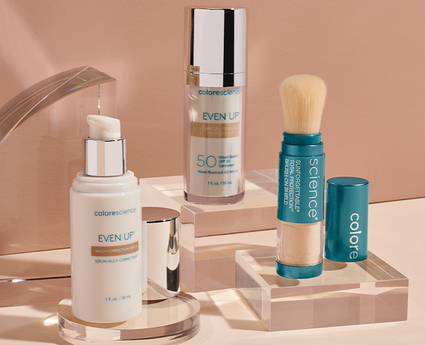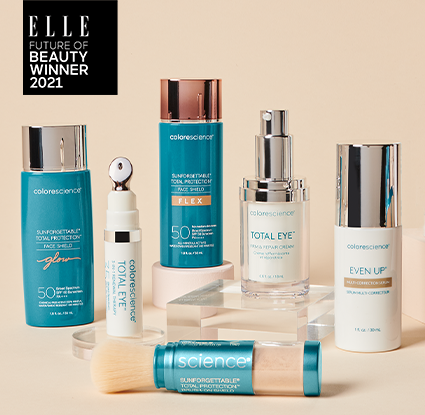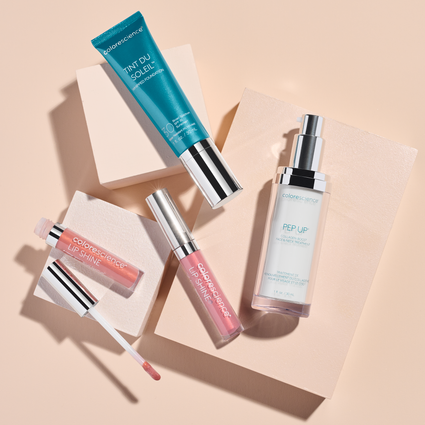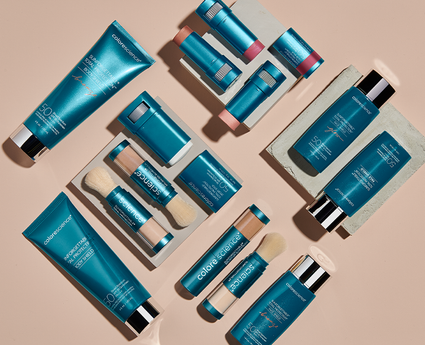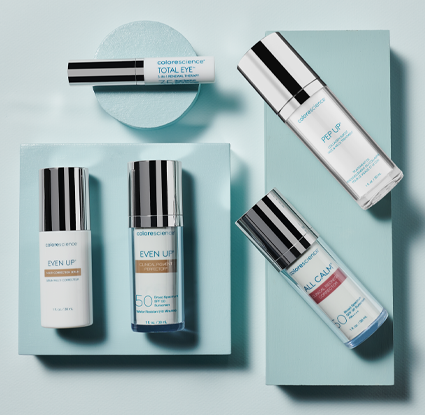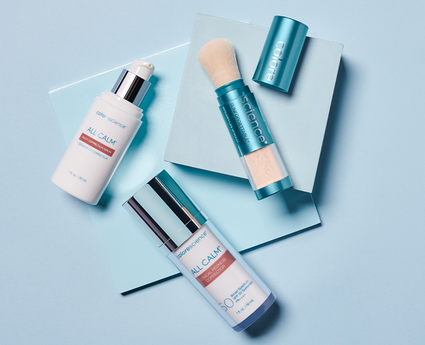Face Redness: How to Get Rid of Red Spots on Your Face
Many people struggle with red, swollen skin. Facial redness can be caused by a host of conditions, including sun damage, rosacea, seborrhea, and acne. If you’ve been dealing with rough, red skin and want to alleviate this sometimes painful condition, it’s important to learn what might be causing your facial redness.
In order to treat your facial redness, it’s important to examine the causes behind it.
Facial redness causes run the gamut, ranging from serious diseases like lupus to mild cases of eczema. Take a look at eight of the most common factors behind facial redness and discover ways you can both treat redness instantly, and better maintain a radiant, smooth complexion.
- Why Is My Face Red?
- How To Reduce Redness On Face
- Most Common Treatments For Facial Redness
- 5 Ways You Could Be Making Facial Redness Worse
- How To Get Rid Of Face Redness Quickly
- When To See A Doctor To Address Face Redness
- Frequently Asked Questions
- Restore A Calm Complexion & Feel Confident In Your Skin
Why Is My Face Red?
Waking up with a red face is undoubtedly alarming and leaves you wondering what could have possibly caused it. Face redness will look different for everyone. Some people will have spidery blood vessels scattered around their face. Other people will have flushed skin on their cheeks. But in order to get rid of those pesky red spots on your face, you need to identify the root cause of them.
There are a myriad of factors and conditions that can cause your face to appear red or blotchy, which we’ll get into below.

1. Rosacea
One of the most common reasons for a red complexion is rosacea. This is a common, incurable, chronic skin condition that can mimic adult acne. This condition typically affects the central portion of the face, particularly the nose.
The symptoms of rosacea can include:
- Facial redness
- Small red pimples
- Find red vascular lines on the face
- An enlarged red nose with bulbous qualities
- Eye issues, which may include red, swollen eyelids, conjunctivitis, and cornea inflammation
If you’re experiencing these symptoms, rosacea could be to blame. This common skin condition affects at least 14 million people in the United States, and tends to be more prevalent among Caucasian people with fair skin.
For many, rosacea goes undiagnosed for years. Many mistakenly believe their rosacea flare-ups are just a sign of sensitive or flushed skin, but that’s simply because this auto-inflammatory condition can ebb and flow. Unlike acne, rosacea isn’t outgrown but there are treatment options and products like rosacea face cream that can reduce redness and lessen its symptoms.
What causes rosacea?
While the exact cause of this skin condition is still unknown, rosacea can flare up for a variety of reasons, including abnormal reaction of blood vessels, bacteria, improper use of facial products, sun exposure, and lifestyle triggers, like alcohol abuse and poor diet habits.
Identifying Rosacea for Darker Skin Tones
Rosacea presents itself differently in darker skin tones, and often goes undiagnosed due to the lack of trademark rosacea redness. On deeper skin tones, one of the first signs of rosacea is often a consistent warm feeling on the skin. This can be followed by acne-like breakouts that don’t clear up with the use of acne medication.
The breakouts can also appear as yellowish-brown bumps that occur on the mouth, eyes, or both. Your skin might become dry or swollen, and certain areas may appear darker and discolored.
2. Acne
Acne is the most common skin disorder in the United States, and affects approximately 50 million Americans annually. This sometimes painful skin condition often begins in adolescence, when young men and women begin puberty; while many see their acne woes disappear after reaching adulthood, many deal with adult breakouts resulting in facial redness and painful, swollen blemishes.
What Causes Acne?
Acne forms when the tiny pores on the surface of your skin become plugged with oil, dead skin cells, bacteria, and debris. Each of your pores opens up to a follicle beneath the top layer of your skin; each of these follicles contains a single hair and a sebaceous gland. The latter is responsible for producing sebum, a waxy substance that keeps your skin soft and supple.
When hormonal fluctuations occur, this gland pumps out an excess of sebum. This oily substance can pick up dead skin cells and bacteria on its way out of the pore, creating a plug. When the plug presses against your skin, your body sends red and white blood cells to fight infection. The result? A painful pimple that may be surrounded by facial redness that’s sensitive to the touch.
3. Seborrhea
Seborrhea, also known as seborrheic dermatitis, is a common skin condition that affects millions of Americans each year. Typically, it presents as flaky, red patches. These patches may or may not be itchy, and when this condition is found on the scalp, it can be called dandruff. Most often, you’ll spot these patches on your chest, around your belly button, on the buttocks, in skin folds under your arms or behind your knees, and within the est, around your belly button, on the buttocks, in skin folds under your arms or behind your knees, and within the groin.
Newborns and adults ages 30 to 60 are most likely to struggle with seborrheic dermatitis, but it tends to be more common in men and those with oily skin.
What Causes Seborrhea?
Healthcare experts aren’t sure exactly what causes seborrhea, but typical culprits include:
- Excess stress
- Genetic predisposition
- A yeast that thrives on the skin
- Medical conditions
- Cold, dry weather conditions
4. Lupus
Lupus is a chronic autoimmune disease that can cause damage to virtually every part of the body, including organs, joints, and the skin. This condition is relatively rare; there are 16,000 new cases reported in the United States each year. It’s most commonly seen in women, but men, children, and teenagers can develop this condition as well.
What Causes Lupus?
Many researchers believe that lupus develops as a result of a combination of factors, including genetic predisposition, hormonal imbalances, and environmental factors. There are more than 50 genes associated with lupus, but none of those have been proven to be a direct link. When it comes to environmental factors, researchers are split. Most believe a virus or chemical can trigger the disease, but other examples of potential triggers include UV rays, infections, colds, exhaustion, and emotional stress.
5. Eczema
If your facial redness consists of dry, scaly patches and itchy, cracked skin, you may have eczema. This common, chronic skin condition appears first as dry red and brown patches in skin folds—often inside of elbows, behind the knees, on the underarms—or on the face, neck, hands or feet.
Eczema is truly an umbrella term; it can be used to describe many rash-like skin conditions, or may be used in reference to atopic dermatitis, a skin condition most common amongst infants and young children. Over 10% of Americans have some form of eczema.
What Causes Eczema?
Researchers have been unable to pinpoint a direct cause of eczema, but believe that it develops due to a combination of both genetic and environmental factors. Some of these factors include certain irritants found in soap, detergent, shampoo, and juices. Environmental factors may also include certain foods (especially dairy products) and extreme temperatures. Like acne, hormonal fluctuations can also cause eczema flare-ups and excess facial redness.

6. Psoriasis
Psoriasis is a skin condition that causes red, itchy patches on the skin. This condition is quite common—approximately 7.5 million people in the United States suffer from psoriasis.
Psoriasis looks different for everyone, but some common symptoms include dry, cracked skin, red patches, and itching and burning. Psoriasis mostly appears on the lower back, elbows, knees, and legs, but it’s possible to get these red patches on your face as well. Certain things can trigger psoriasis, like cold weather, stress, smoking, and heavy alcohol consumption. There is no cure for psoriasis, but there are various treatments available to manage symptoms
What Causes Psoriasis?
Psoriasis causes your skin to regenerate at a quicker pace than normal, resulting in these red patches on your skin. The exact cause of psoriasis is unknown, but genetics and environmental factors are thought to play a role. Anyone can develop psoriasis, but certain factors can increase your risk, such as family history, stress, and smoking.
7. Shingles
Shingles is a condition that causes a painful, blistering rash. This rash can appear anywhere on your body, from your torso to your face. Symptoms of shingles include pain, burning, sensitivity to touch, a red rash, and fluid-filled blisters. You may also experience a fever and headache.
What Causes Shingles?
Shingles is caused by the varicella-zoster virus, which is the same virus that causes chickenpox. If you’ve had chickenpox, this virus stays inactive in your nerve tissue, but it can reactivate as shingles. Shingles is often triggered by a weakened immune system. The best way to reduce your risk of developing shingles is with a vaccine.
8. Allergic Reaction
An allergic reaction, also known as contact dermatitis, is another possible cause of face redness. An allergic reaction is a red, itchy rash that develops when your skin comes in contact with something that you’re allergic to. Contact dermatitis isn’t life threatening, but it can be very uncomfortable. It’s a very common condition—approximately 1 in 5 people experience allergic contact dermatitis.
Symptoms of an allergic reaction can include a red rash, itching, dry, cracked skin, bumps, and blisters. Symptoms can develop within minutes to hours of being exposed to the irritant.
What Causes an Allergic Reaction?
An allergic reaction is caused when you’re exposed to a substance that irritates your skin. There are two different types of contact dermatitis: irritant contact dermatitis and allergic contact dermatitis. Irritant contact dermatitis is the most common type and occurs when a substance damages your skin’s protective layer. Allergic contact dermatitis occurs when you come in contact with a substance you’re allergic to and it triggers an immune reaction on your skin.
9. Spider Veins
Spider Veins are actually not veins but clusters of weak or damaged capillaries that appear in red or blue spider web-like shapes beneath the surface of the skin. They commonly appear on the legs but can also occur on the face around the nose, cheek, and chin areas.
Unlike varicose veins, which can be a sign of a more serious health issue, spider veins on the body are often harmless. While symptoms related to spider veins are rare, sometimes people can experience itching or general discomfort, usually associated with spider veins on the legs. Those who seek treatment for spider veins often do so solely for cosmetic purposes.
What Causes Spider Veins?
The root cause of spider veins or broken capillaries can be difficult to identify, but common culprits seem to be sun damage, changes in hormones, and injuries to the area. And as with many health issues, a genetic history of spider veins make it more likely for a person to inherit a weakness in the capillaries that cause them to break down.

How to Reduce Redness on Face
Once you’ve identified the root cause of the red patches on your face, then you can find the proper treatment for it. You can treat face redness with various at-home remedies but it’s always a good idea to see a doctor so you can be sure it’s not something more serious.
Here are some ways to reduce red blotches on your face:
Rosacea: Treatment and Prevention
You can’t prevent rosacea, but you can commit to avoiding certain triggers. If you believe your facial redness is caused by rosacea, avoid eating spicy foods, and smoking, and wear only high-quality SPF cosmetics that offer sun-blocking protection without clogging pores.
Acne: Treatment and Prevention
If you’re struggling with acne, it’s important to follow a daily skin care regimen using products that are gentle on the skin. With facial redness, it’s especially important to avoid abrasive products, in terms of cleansers and cosmetics. Gently dab your face and avoid harsh scrubbing to prevent further irritation.

Seborrhea: Treatment and Prevention
Seborrhea is typically a lifetime condition that can be controlled with the right habits. However, if your seborrhea is caused by an underlying medical problem, treatment of the issue may clear up your facial redness and dryness.
Rest and exercise can help to reduce stress, which in turn reduces the likelihood of seborrheic dermatitis flare-ups. Wash every day with a gentle cleanser, and consider using medicated shampoos and sulfur products to control this condition.
Lupus: Treatment and Prevention
Lupus isn’t preventable, but early diagnosis can help manage this disease. If you believe you have lupus, it’s important to see a rheumatologist, who can treat the condition through a variety of medications.
Eczema: Treatment and Prevention
There is no cure for eczema, but there are ways to reduce the appearance and frequency of these flare-ups. There are certain creams and ointments that doctors can prescribe for more severe cases of eczema, but there are some easy DIY ways to combat the facial redness and itching associated with this skin condition.
Try one of these home remedies to treat your eczema:
- Take a lukewarm bath
- Apply moisturizer regularly
- Wear breathable fabrics
- Pat skin dry instead of rubbing
- Avoid triggering factors
You can check out the National Eczema Association for more information on how to go about treating eczema and other types of dermatitis.
Psoriasis: Treatment and Prevention
While there is no exact cure for psoriasis, the goal of psoriasis treatment is to stop the skin cells from regenerating so quickly. You can do this with topical therapy, light therapy, or oral and injected medication. The treatment method you should use depends on the severity of your psoriasis.
You can also do various things to prevent psoriasis flare-ups, such as avoiding cold weather, taking good care of your skin by moisturizing regularly, reducing stress, and using a humidifier.
Shingles: Treatment and Prevention
There is no treatment for shingles, but there are ways to expedite the healing process to reduce the risk of further complications. You can do this by taking medication or getting an injection that contains corticosteroids and local anesthetics.
Shingles can be very painful and detrimental to your health if not treated. According to the American Academy of Dermatology Association, if you have shingles on your face that go untreated, it can cause permanent eye damage. Taking an antiviral medication can save your eyesight and prevent long-term nerve pain.
Allergic Reaction: Treatment and Prevention
The best way to prevent an allergic reaction is to avoid the substance that you’re allergic to. This isn’t always easy, so if you can’t avoid the allergen entirely, try to reduce your exposure to it as much as possible. It’s also important to take your allergy medication as prescribed if you do find yourself having a reaction. If you have a severe allergy, make sure you keep your epinephrine auto-injector on you at all times.
Most Common Treatments For Facial Redness
If persistent facial redness is what’s keeping you from achieving a balanced skin tone, you may want to consider a treatment that specifically targets redness. There’s a wide array of over-the-counter and prescription treatment options that help reduce red spots on your skin.

Topical Treatments
When it comes to treating redness, the most common and readily available option is over-the-counter topical treatments. Specially formulated products, including those featured in our clinically-proven All Calm® Sensitive Skin Regimen, can be very effective additions to your skincare routine. The regimen includes:
All Calm® Clinical Redness Corrector SPF 50 minimizes redness, soothes, and protects skin from the powerful UV rays that contribute to redness. The patented BioSolace® ingredient complex helps provide ongoing relief from sensitivity and the appearance of redness while all-mineral SPF 50 sunscreen protects skin from further irritation by the sun and other environmental aggressors such as HEV (blue) light and pollution
All Calm® Multi-Correction Serum is a lightweight, calming serum that features the same proprietary BiolSolace® ingredient complex to help calm sensitive skin. With continued use, it can help address the appearance of redness in your complexion. It also helps improve moisture retention, contributing to skin barrier health and softer skin.
For those who want a base for your makeup that extends wear while helping with redness and sensitivity, our Calming Primer SPF 20 is the perfect solution. It’s color correcting, contains SPF 20 to protect skin from harmful UV rays, and is formulated specifically for sensitive skin types.
If you’re looking for an untinted sunscreen that is still friendly to sensitive skin, the Total Protection® No-Show™ Mineral Sunscreen SPF 50 is a great choice. This sheer, ultra-lightweight mineral sunscreen blends seamlessly with your complexion and leaves your skin feeling velvety soft.
Laser & Light Therapy
Laser and light treatments, while usually more expensive than the topical route, can be very effective in treating a myriad of skin conditions, including facial redness. For example, the pulsed dye laser treatment–or PDL– is often recommended for those with rosacea or spider veins on their face as it treats redness by eliminating the problematic blood vessels beneath the skin.
General redness can be a bit harder to treat and may require more sessions for optimal results. Those who opt for laser treatments do so because, in addition to their effectiveness, they are non-invasive and require minimal recovery time.
Medications
Oral acne medications like doxycycline are often prescribed for acne and rosacea and can alleviate the redness associated with the condition. Topical medications like azelaic acid and benzoyl peroxide have been shown to be effective in reducing general redness. If you’re considering medication to treat a skin condition, consult with your dermatologist to formulate the regimen that will work best for your skin.
5 Ways You Could Be Making Facial Redness Worse
Facial redness can affect anyone at any age, but there are certain triggers that can contribute to red skin. Make sure you’re not unwittingly adding flame to the fire. Here are five things that can make your facial redness worse:
- Stress: We’ve long been told that stress affects our health in a variety of ways, so it should come as no surprise that excess stress can make facial redness worse. To prevent stress-induced redness, practice meditation, exercise regularly, and be sure you’re getting the adequate amount of rest.
- Sun Exposure: We all know spending too much time in the sun, especially when there’s a high UV index, can cause a sunburn, but any type of sun exposure can make facial redness worse. The UV rays from the sun trigger your blood vessels to grow; the only way to reduce this is through laser treatment. Be sure you’re applying sunscreen every time you head outside. Sunforgettable® Total Protection® Brush-On Shield SPF 50 is easy to take on the go.
- Alcohol: Alcohol causes inflammation throughout your body, and this inflammation is easy to spot on your skin. Excess alcohol causes the small blood vessels in your skin to widen, allowing more blood to flow close to the surface of your skin. This can lead to flush, which may cause capillaries to break. Drink in moderation to avoid these harmful effects.
- Poor Quality Cosmetics: Using poor-quality cosmetics with harmful ingredients can irritate the skin, resulting in itchy redness. Always select high-quality products, like this face cream for redness, that both treat your skin while providing the look you want. Browse Colorescience for products that offer SPF protection and a flawless finish.
- Spicy Foods: If you’re struggling with rosacea or another form of facial redness, leave the spicy foods alone. In a recent study, it was found that spicy foods can trigger rosacea signs and symptoms. It turns out spicy foods can dilate blood vessels in the skin, increasing the appearance of facial redness.
If you’re looking for a facial redness treatment, first consider the causes behind your skin irritation. Finding the root of the problem helps you discover the best solution, so talk to your health care provider and try some of the above remedies for facial redness.
How to Get Rid of Face Redness Quickly
If you wake up the morning of a big event with a beet-red face, don’t panic. There are many ways to get rid of face redness quickly that don’t require a trip to the dermatologist’s office. Some things to try are:
- Makeup: Foundation and concealer are easy to apply and reduce the visibility of your redness instantly.
- Soothing masks: You can use a face mask with soothing ingredients that reduce redness and inflammation. Ingredients like chamomile, aloe, and cucumber are great at reducing face redness.
- Switch up your products: If you’re suddenly experiencing red spots on your skin, it could be because of a certain skin product you’re using. If you think this is the case, stop using all your skin products, go back to the basics, and see how your skin reacts.

When to See a Doctor to Address Face Redness
While you may be able to treat your face redness with home remedies, you may want to consider seeing a doctor to have your condition checked out and diagnosed. You should see a doctor if:
- Redness continues for extended periods of time
- You experience burning and irritation around your eyes
- You’re having a flare-up
A doctor may also be able to administer treatments that you couldn’t do yourself, such as laser treatment and allergy testing. Overall, you’re always better off safe than sorry, so if facial redness persists, it can’t hurt to see a doctor to have it checked out. The sooner you talk to a professional, the quicker you can get redness under control with the right treatment.
Frequently Asked Questions
Can Facial Redness Worsen with Age?
Yes, facial redness can increase as we get older for many reasons. As we age, the skin gets thinner and blood vessels beneath the surface can appear more visible. Visible redness caused by sun damage also tends to appear with age, and certain skin conditions that cause redness like rosacea can onset with age, often around middle age.
What Can Cause Sudden Facial Redness?
Things like allergic reactions, sunburn, high temperatures, alcohol, spicy foods, and physical exercise can cause a sudden increase in facial redness. These are often temporary reactions that are harmless and will go away on their own, but be sure to seek medical treatment if necessary.
What Other Symptoms Often Occur with Facial Redness?
Facial redness can be accompanied by a burning or stinging sensation, and sometimes, the reddened skin can become rougher in texture.
Restore a Calm Complexion & Feel Confident in Your Skin
Waking up in the morning to a red face can definitely put a damper on your confidence. But fortunately, there are many ways you can go about treating facial redness so that you can feel confident in your skin once again. Whether that’s with at-home remedies or with the help of a dermatologist, there’s a treatment out there for your case of facial redness.
If you’re looking for high-quality skin products that can help with rosacea and redness on your journey to more balanced skin, look no further than Colorescience. We offer a special skin care regimen that’s designed specifically to address face redness. With the right treatment in your arsenal, you won’t ever have to cancel plans because you woke up with red skin. Find the right solution today!

